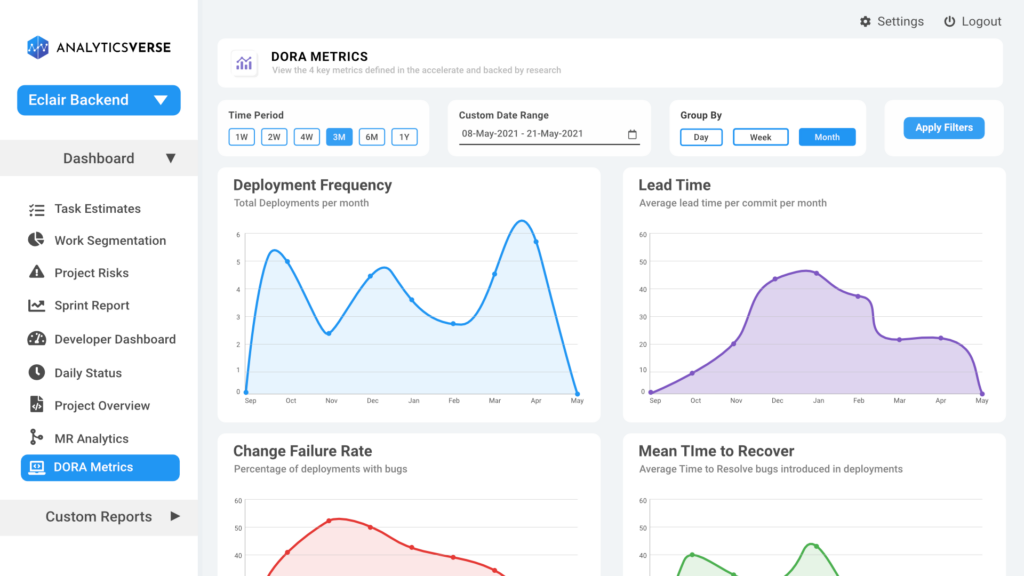
DevOps practices have become integral to modern software development, emphasizing collaboration, automation, and continuous delivery to accelerate the software delivery process. As organizations strive to adopt and optimize DevOps methodologies, measuring performance becomes crucial for assessing progress and identifying areas for improvement. The DORA (DevOps Research and Assessment) metrics framework provides a standardized set of metrics designed to gauge the effectiveness of DevOps practices and drive continuous improvement. In this article, we’ll explore how to effectively use DORA metrics in DevOps initiatives.
Understanding DORA Metrics
DORA metrics were developed by the DevOps Research and Assessment (DORA) team, now part of Google Cloud, based on extensive research and analysis of high-performing DevOps organizations. These metrics focus on four key areas:
- Deployment Frequency: How often code changes are deployed to production.
- Lead Time for Changes: The time it takes for code changes to go from committing to version control to being successfully deployed to production.
- Mean Time to Recover (MTTR): The average time it takes to restore service after a failure or incident occurs.
- Change Failure Rate: The percentage of deployments that result in a failure or require remediation, such as rollback or hotfix.
Using DORA Metrics Effectively
To leverage DORA metrics effectively in DevOps practices, consider the following best practices:
1. Define Clear Objectives:
Clearly define your organization’s objectives and goals for adopting DevOps practices. Determine which aspects of your software delivery process you aim to improve and how DORA metrics can help measure progress towards those goals.
2. Select Appropriate Metrics:
Choose DORA metrics that align with your organization’s objectives and are relevant to your software delivery process. While the four core metrics are foundational, you may also consider additional supplementary metrics that provide deeper insights into specific areas of interest.
3. Establish Baselines:
Establish baseline measurements for each DORA metric to understand your organization’s current performance levels. Baselines serve as reference points for tracking progress over time and identifying areas where improvement is needed.
4. Continuously Monitor and Measure:
Regularly collect and analyze data on DORA metrics to monitor performance trends and identify patterns or anomalies. Use automated monitoring tools and dashboards to streamline data collection and visualization, enabling real-time insights into your DevOps practices.
5. Identify Improvement Opportunities:
Use DORA metrics to identify areas for improvement and optimization within your software delivery pipeline. Analyze performance bottlenecks, process inefficiencies, and areas of high change failure rate to prioritize improvement efforts effectively.
6. Foster Collaboration and Accountability:
Encourage collaboration and cross-functional teamwork among development, operations, and quality assurance teams to collectively improve DevOps practices. Establish accountability for meeting performance targets and driving continuous improvement based on DORA metric measurements.
7. Iterate and Adapt:
DevOps is an iterative process, and continuous improvement is key to success. Regularly review and refine your approach to using DORA metrics based on feedback, lessons learned, and changes in organizational priorities or objectives.
Conclusion
DORA metrics provide a valuable framework for measuring and improving DevOps practices, helping organizations accelerate software delivery, increase reliability, and enhance overall performance. By understanding the core DORA metrics, setting clear objectives, establishing baselines, continuously monitoring performance, and fostering collaboration, organizations can effectively leverage DORA metrics to drive meaningful improvements in their DevOps initiatives. Embracing a data-driven approach and cultivating a culture of continuous improvement are essential for maximizing the benefits of DORA metrics and achieving DevOps excellence.